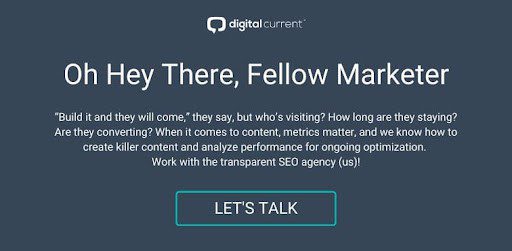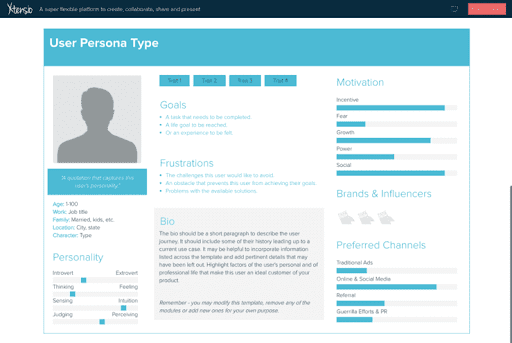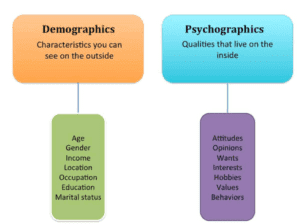You’ve decided to include content marketing and search engine optimization (SEO) as part of your overall marketing strategy. You write blogs. You release ebooks and whitepapers. You’ve spent a fortune on video production.
And yet, nothing is happening. Your analytics show that you’re getting traffic, but you aren’t seeing conversions. So what’s wrong? You might not know enough about your customer.
The Importance of Knowing Your Audience
No one in the marketing field would argue with you if you claimed that any successful strategy depends on understanding your customer. Still, 63% of respondents in an Ascend2 survey say that data-driven personalization is a difficult tactic to execute.
Consumers are bombarded with thousands of marketing messages every day, and most are highly adept at filtering out those messages not relevant to them. That means that, as a marketer, you need to have a firm handle on your audience: Chiefly, who they are and what they want. If you don’t, you risk having your contributions lost in the ever-growing cacophony of marketing noise.
Many business owners assume they know their customers without actually verifying those descriptions against hard data. Based on those assumptions, they make a wide range of decisions related to merchandising, marketing, advertising, and even store location. Decisions based on faulty assumptions won’t drive business growth. At worst, they can prove to be fatal.
In this case, what you don’t know can hurt you. Even if you think you know who your customers are, you’ll want to take a step back and develop a clear picture of your audience with customer profiles, marketing personas, and buyers’ journeys.
Accurate, verifiable buyer personas are the backbone of content marketing. But you’ll also need robust buyer personas and customer journey maps to help you maintain a continuous conversation with your customers via your content. Not only can this allow you to solve problems and boost brand awareness, but you’ll also deliver better leads to your sales team – and convert more leads to customers as a result.

Why Make the Effort?
It’s quite simple really: If you don’t understand your audience, how can you possibly give them what they need or want? As Hubspot’s Sam Kusinitz notes, “Buyer personas provide tremendous structure and insight for your company. A detailed buyer persona will help you determine where to focus your time, guide product development, and allow for alignment across the organization.”
When you’re developing a content strategy, knowing who you’re writing for helps you develop content that resonates and allows you to distribute that content strategically. No matter what type of content you’re creating, you can ask, “Will this content meet the needs of my buyer? Will it resonate with them and spur them to action?” – and answer “yes” with confidence.
Still Not Convinced? Check This:
When Jan Carlzon took over SAS Group in 1981, the Scandinavian airline company was losing $17 million per year and had a reputation for being the least punctual airline in Europe. By 1982, SAS Group was making a profit of $52 million and had become the most punctual airline in Europe thanks to Carlzon’s “Putting People First” campaign. “If you’re not serving the customer,” Carlzon famously said, “your job is to be serving someone who is.”
If you’re primarily a B2B company, you may not serve consumers directly – but you do serve a company that is serving consumers. Even though your client’s customers are a step removed from you, they’re the force behind every decision your client makes. By conducting comprehensive customer reviews for both current and prospective clients, you’ll get to know your clients even better than they know themselves.
Know What Your Customers Really Want: A Preliminary Approach to Understanding Your Audience
In some cases, a business perceives an industry in a certain way even when customer behavior clearly tells another story.
In the 1990s, Polaroid still envisioned itself as an instant photography company when customers were ditching instant film (a market they had dominated for decades) in favor of digital photography. Instead of accepting what customers’ behavior said about its core product, Polaroid kept selling instant film and failed to capitalize on digital. In 2001, Polaroid filed for Chapter 11 bankruptcy – a sad ending for a company that had become an American institution.
But as you probably know, Polaroid bounced back somewhat by finding a niche market for instant film, developing trendy and kitschy new products as well as meeting their customers in new markets: Digital cameras, printers, high-def televisions, and more.
Your job as a marketer is to understand what customers buy from your company and competitors. Ask yourself some questions about your company, your competition, and the industry overall. Evaluate what customer behavior says about the market and its players by examining…
- Company history: How did your company and its competitors get started? What need did the company fulfill when it offered its initial portfolio? How has it adapted to customer needs over time?
- Industry and company trends: What does current customer purchasing behavior say about industry trends? Are you hanging onto the past or do you have a forward-looking business plan?
- Core products: What products do customers purchase the most? Does the company place priority on certain products or promotions? Have sales ratios changed due to evolving customer’ purchasing behavior?
- Cycles: Do the company and the industry share a predictable seasonal sales cycle? Are sales of certain products or services driven by specific events or recurring situations?
- Revenue: How does the company make its money? Are competitors innovating in a way that’s eroding the customer base?
To get the answers you need, you can read articles about your company, your industry, and your competitors in business magazines and blogs; set up Google Alerts to monitor your company’s press and perception; review annual reports; and keep a close eye on any analytics to which you have access.
Learn How Your Customers Prefer to Buy…
Blockbuster Video did just fine when customers switched from VHS to DVD because it adapted to customer buying preferences. However,the company later failed to adapt its outdated products and processes when those preferences changed on a larger scale.
Customers stopped buying and renting movies via retail stores because they wanted to access entertainment without ever leaving their homes. They enjoyed the convenience of Netflix, which sent DVDs through the mail, or they ordered video on demand from their cable companies. Blockbuster actually had a chance to buy Netflix in the early 2000s, but executives considered Netflix’s movie delivery model to be a non-competitive niche. In 2010, Blockbuster filed for bankruptcy after reporting a $1.1 billion loss, and Blockbuster shuttered its last stores in late 2013. (Technically, there’s one last Blockbuster store remaining. Head to Bend, OR, for a final dose of nostalgia.)
You can keep your company from becoming like Blockbuster by understanding how your customers like to buy their products. Remember, the appeal of movies didn’t inherently change — the way they’re consumed is what shook the industry.
You’ll want to evaluate your sales funnel, buyer behavior, and customer acquisition processes to determine how your customers prefer to buy, where you might be coming up short, and which gaps you can fill. We’d also recommend you audit your website for any functional or user experience issues, delve into pertinent metrics in Google Analytics (like CTR, bounce rates, and conversion rates), and calculate your value per lead (VPL) to determine whether there are improvements to be made.
…And Why They Buy
Here’s another example of when a big company made decisions based on bad assumptions about their customers. In 2010, J.C. Penney’s annual revenue had taken substantial hits from both the economic recession and the explosion of online shopping. The company hired Ron Johnson, the brains behind the Apple stores who had also revived Target’s image. Johnson became CEO and was tasked with re-envisioning the Penney’s brand.
Johnson conceptualized a younger, bolder Penney’s, so he applied the boutique setup he’d used at Apple and Target. He also eliminated Penney’s sales and coupons in favor of everyday low prices. His strategies may have worked well at those other stores, but Penney’s customers ended up feeling alienated. No coupons or discounts meant no sense of urgency, so current customers had no reason to come shop. Even worse, the younger and trendier customers that Johnson assumed would flock to Penney’s never showed up to replace the ones that Johnson drove away.
Johnson lost his job in 2013 because he didn’t appreciate why current customers shopped at J.C. Penney in the first place – and he didn’t give new customers a reason to fill the void. To avoid his same fate, you need to know why current customers buy from your company and why new customers might start shopping there. Pay attention to:
- Persona – Your typical customer, their demographic characteristics, their habits, and their motivations
- “Watering Holes” – Where your customers hang out (physically and digitally), the media they consume, the groups they belong to, and the sites/apps they use
- Mood – The public perception of your company and what customers are saying about your brand
You can obtain this information through customer surveys, social listening, and CRM-powered data mining through a digital marketing agency or external platform.
Once you know your customers, you’re ready to define your customer personas and build out your target audience.
A Deep Dive Into Marketing Personas and Customer Journey Maps
Obviously, you understand the value of zeroing in on your target customer base and developing (and using!) personas and customer journey maps. But not everyone on your team may feel the same way. So how can you convince them?
The Numbers Don’t Lie
Data proves that marketing personas and customer journey maps work. Consider this:
- 79% of customers are more loyal to a brand that understands them
- 57% of consumers are willing to share personal data in exchange for personalized offers or discounts
- 39% of marketers reported seeing “major uplift” from personalization in search engine marketing (SEM), while just 7% reported no impact
- Email personalization generates 17% more revenue than the average campaign
- Marketing personas made websites 2-5 times more effective and easier to use
- 3-4 personas typically account for 90% of a company’s sales
- At Digital Current, we’ve achieved better results for our clients using these methods, including 16.5% increase in organic conversions for Syniverse
How are Personas and Customer Journey Maps Used?
Personas serve as the foundation for countless successful marketing campaigns, partially because they have countless applications, including:
- Content strategy
- Customer service
- Human resources
- Ad development
- Email/social targeting (and retargeting)
- Landing pages
- Web development/UX
- Recruitment and hiring
While customer personas are used to define your target audience, customer journey maps (also known as buyer’s journey maps) are used to plot out the touchpoints of a prospective customer, defining each stage of the buying process.
These maps are useful on their own to ensure those touchpoints exist, but they’re also helpful when combined with personas. When a persona is applied to a customer journey map, marketers can more adeptly meet that persona’s expectations at specific moments in the buying process, which can alleviate pain points, answer questions, and support goal achievement. This can also serve as an auditing tool, highlighting potential content strategy gaps.
Profile vs. Persona: What’s the Difference?
You might think profiles and personas are interchangeable, but the main difference between customer profiles and customer personas comes down to specificity.
Tony Zambito notes that ideal customer profiles are more focused on traditional sales and marketing approaches. These profiles tend to focus on the money: Usually, who is capable of buying – not necessarily whether or not they’re interested in buying. But, as he points out, these profiles aren’t based on deep buyer insights and don’t really get to the heart of why customers really make decisions. They don’t say anything about a customer’s values or delve into their experiences. In other words, they’re the “what” – not the “how” or the “why.”
A buyer persona, on the other hand, is a detailed, quasi-fictional representation of the target customer that reveals the individual behind those demographic categories. This persona is a specific individual who represents your typical or ideal customer — a person with a name, a photo, and real motivations, values, preferences and dislikes. The more detailed the persona, the better; it should explain what makes your customer tick and how and why they make their decisions. The buyer persona takes you inside your customer’s mind and heart, offering insights not only into who they are, but also why they do what they do (or more importantly, why they buy what they buy).
The customer journey map is the perfect accompaniment to your buyer persona. It shows you how your customer interacts with your brand and others — including non-competitors — along their path to purchase. It’s a roadmap of awareness, consideration, conversion, advocacy, and loyalty, allowing you to anticipate their needs, wants, and behaviors at every turn.
Getting Down to Business: Creating your Buyer Personas and Customer Journeys
We’ve broken down each process into steps that will guide your persona creation and journey mapping. Following these steps, you can bolster your personas and journeys, mine for information, organize your research, and cover every aspect of your audience.
Begin With Customer Profiles
The first step is to develop the ideal customer profile. Again, this profile is different from the persona; we’re aiming for generic, overarching information here. You can cull this information from your customer data, as well as based on the market research you’ve done to determine who your product appeals to. As you develop the profile, it should include the following information.
B2C:
- Age
- Gender
- Marital status (if applicable)
- Geographic data (country, region, ZIP code)
- Household income
- Household size
- Homeowner status
- Education
- Special characteristics (children, pets, hobbies, interests, political affiliations, etc.)
B2B:
- Industry
- Products
- Geographic data (country, region, ZIP code)
- Number of employees
- Number of locations
- Length of time in business
- Annual revenue
Once you have a customer profile, you can move on to creating a persona.
A Crash Course in Persona Development
The most important rule of persona creation: You can’t base them on assumptions, existing customer data, or anecdotes from your sales and marketing staff. You also can’t base personas solely on what you glean from the social media profiles of the people who engage with your company online. That information may be useful in creating a customer profile in that it provides some general demographic insights, but it doesn’t give you what Tony Zambito calls the “customer archetype.”
Persona development requires personal interviews with a few dozen people within your target demographic, based on your ideal customer profile. These are qualitative discussions in which you learn more about your existing and potential customers through in-depth conversation. We’ll go over exactly what kind of topics you should cover below.
However, as Zambito cautions, avoid collecting reams of data that fog the qualitative value of the exercise. Buyer persona research is about drawing conclusions and making connections based on qualitative insights drawn from the context of a buyer’s goals and desires.
During this process, you’ll need to have a deep familiarity with the brand and goals, collect and analyze your data, and consolidate key themes, pain points, and common questions discovered in your interviews. Then, you can use a tool like Extensio Persona Template to build out your personas, validate your persona with your interviews and survey data, and refine key characteristics based on that data. You’ll want to periodically revisit your personas for accuracy over time.

As you chat with your subjects, you’ll want to address both demographic and psychographic information to get a clear picture of your final personas.
 These interviews should allow you to gather:
These interviews should allow you to gather:
- Demographic information – For B2B, this includes job title, length of employment, and company information. For B2C, you’d focus on household income, age, geographic information, household makeup, and gender.
- Job information – Get more specific and learn about coworkers, job descriptions, hierarchy and management, etc.
- Typical schedule – Find out how your interviewee spends their time on an average day (i.e., how much time is spent at home or work, what tasks must be completed, and what tasks are perpetually left undone).
- Likes, dislikes, and pain points – Learn their sources of happiness and frustration, daily struggles, challenges, and associated feelings.
- Wants and needs – Look at this from the perspective of their life, their job, and the companies they buy from.
- Value – What gets them excited about a product or service? What turns them off? What are they really looking for?
- Goals – Where do they want to be in one, five, or 10 years from now?
- Information – How do they get it? What kind of information is valuable to them in the buying process?
- Social media use – Discover how much time they spend on it, which platforms they use, how they engage with brands, and whether this fuels their shopping habits.
- Barriers – Learn what keeps them from finding a solution, meeting their goals, easing their pain points, and choosing your product/service.
What Problems Can You Solve for Them?
Some purchases happen simply because someone sees something shiny and new. Most purchases, however, happen because a customer has a problem. With persona-based marketing, you show your customers that your products and services are the solutions to their problems.
After you’ve identified your target buyer’s characteristics, ask yourself what problems of theirs you can solve.
- What are their day-to-day frustrations?
- What are their aspirations?
- What do they like or dislike about their current product?
- What are the larger goals of the business (for B2B personas)?
- How can you make this person look good in front of bosses or clients?
- Can they buy directly from you or do they have to run it up the chain of command?
Be Careful — Don’t Make These Mistakes
Buyer personas are powerful tools. They form the foundation of your content strategy. But when they’re poorly developed, they’re little more than creative writing exercises.
Some of the most common mistakes that marketers make when developing buyer personas include:
- Letting stock photos drive your descriptions
- Failing to talk to enough or the right people
- Not digging deep enough
- Creating too many buyer personas
Buyer personas aren’t collections of statistical data culled from customer lists or vague surveys. They’re manifestations of the real people at the other end of the sales funnel. When you understand who they are and what they really want, you’ll create a more effective and engaging persona-based strategy that speaks to their needs and spurs them to action. And this will naturally lead you to begin analyzing your customer’s buying journey.
So, without further ado, here are…
7 Steps to Customer Journey Map Development
A customer journey map is a reflection of real-world buying patterns and important moments leading up to and following a purchase. Throughout your buyer’s journey mapping, you’re going to need to do some serious “put yourself in their shoes” thinking. To develop your map, you’ll need to…
- Create personas. Without personas, there’s no one to go on this journey! Luckily, you’ve already done this part.
- Identify stages. Sketch out (literally!) the following milestones in your buyer’s journey: Discovery, awareness, consideration, acquisition, delivery, and advocacy.
- Identify touchpoints and “moments of truth.” Work with your team to list customer actions (things they do or decisions they make at each stage); touchpoints or channels your customers engage with (websites, social media); pain points they may experience along the way; sentiments, feelings, opinions or attitudes they experience at various stages of the process; and opportunities for your brand to provide value to the persona along their unique journey.
- Build your customer journey map outline. Translate your notes into a visual journey map.
- Validate. Just like with your personas, you need to validate the journey you’ve mapped. Work with real customers to walk through their buying process to identify places for adjustment.
- Refine. Design your final documentation and train your colleagues on how to use it.
- Revisit. Again, like personas, you’ll need to set some kind of cadence to regularly revisit and refine your customer journey maps.
Putting Personas and Customer Journey Maps To Work
Once those steps are completed, you’re not quite done – but at least you’re armed with an arsenal of information on your prospective clients/customers.
Now, it’s time to get specific and show your customers you understand their goals, needs, and pain points. Audience segmentation can help you accomplish this. You’ll want to design distinct ads, content, and experiences for each persona — and make sure they fit into the buyer’s journey at the right time and on the right channel (social, web, email, etc.).
Audience segmentation can mean something as simple as customizing the subject line of your email campaigns. A more complicated example would involve developing completely distinct landing pages and email messages for your different personas. It will likely also include adding topics to your content marketing editorial calendar that speak to distinct personas.
The persona and customer journey map will also tell you how persistent to be — perhaps one persona responds well to a follow-up email, while another gets turned off by too much communication. Stick to email for the former, but pivot to social ads, perhaps, for the latter.
Understanding your audience segments is key to defining impactful marketing techniques that resonate.
Remember, though, that buyer personas and customer journey maps are going to change over time. Establish a cadence that encourages you to review and revise your personas and journeys regularly. They may require only slight tweaks, but if your company or industry has pivoted dramatically, they may need a complete overhaul.
The Final Assignment: Never Stop Learning
While buyer personas and customer journeys are a necessary part of marketing your business, you can’t get too comfortable with the data you gather at any given point. The information you acquire or the content you develop might become outdated sooner than you’d think.
What you learn about who reads your content, and which pieces are the most popular, will help you identify new target buyers and send even more personalized content to existing leads and customers. When it’s done right, content marketing and persona-based strategies can become the driving force behind every marketing decision – both online and off – that your business will ever make.
Need help defining your customer?
If you’re still unsure how to develop a buyer persona and build a customer journey map — or the process just seems too daunting — Digital Current can help! With over a decade of experience developing integrated online marketing campaigns, we know a thing or two about reaching the right audiences with the right message.


